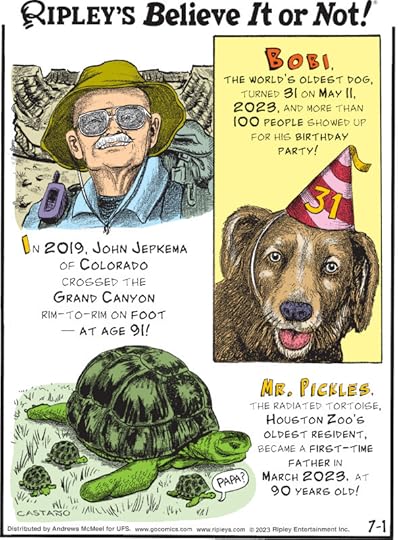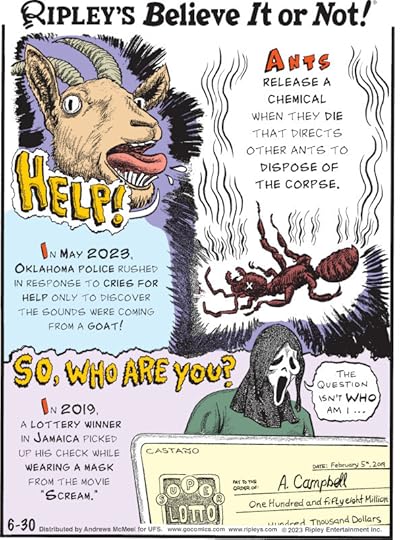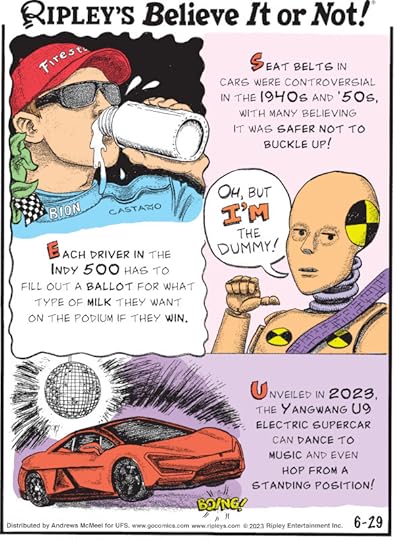Ripley Entertainment Inc.'s Blog, page 19
July 5, 2023
CARTOON 07-05-2023
July 4, 2023
CARTOON 07-04-2023
July 3, 2023
CARTOON 07-03-2023
July 2, 2023
CARTOON 07-02-2023
July 1, 2023
CARTOON 07-01-2023
June 30, 2023
Meet ELIZA: The 60s Chatbot That Set The Groundwork For ChatGPT
Featured in Ripley's Believe It or Not!
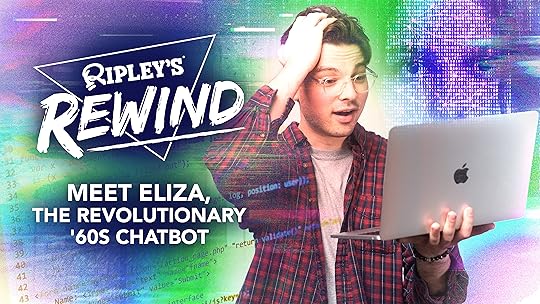
You’ve probably heard of ChatGPT, a computer program that is trained to follow your instruction and provide a variety of wide ranging responses. As someone that has spent some time actually using the AI, I have to say, the results it produces can be eerily human.
But did you know that computer scientists have been working alongside chatbots as early as the 1960s? Today, we are rewinding back and looking at the revolutionary chatbot of the ‘60s known formally as ELIZA. We’re going to be taking a closer look at the curious world of chatbots and examining the existence of ELIZA and the influences it had on ChatGPT as we know it.
The Chatbot BackstoryIt was the late 1960’s and Joseph Weizenbaum, an MIT computer scientist, had just completed work on his revolutionary chatbot ELIZA. Weizenbaum was born in Berlin, Germany, in 1923, and fled the country with his family in 1935 to escape the political turmoil. Weizenbaum came to the United States where his road to computer science would ultimately begin.
After time spent in the Air Force, Weizenbaum would go on to study as a computer scientist and eventually work in the industry. You have to remember, computers at that time were not portable devices that could fit in our pockets. In fact, they often barely fit into a room!
Embed from Getty Imageswindow.gie=window.gie||function(c){(gie.q=gie.q||[]).push(c)};gie(function(){gie.widgets.load({id:'8TB5M531QVBNfy4qvnJFtQ',sig:'mssfIUzCKC3gYhiVZH8UWY7-EDn_UWZrlMp6Do-1iTM=',w:'387px',h:'594px',items:'541556453',caption: true ,tld:'com',is360: false })});As an associate Professor at MIT, Weizenbaum became obsessed with the way computers could directly interact with humans through language. It was this early through line between computers and human language that would work to lay the foundation for his own chatbot and eventually lay the groundwork for the AI development of programs such as ChatGPT, Siri and Alexa.
Meet ELIZAWeizenbaum believed that the most effective way to go about creating a connection between human language and computers would be through mimicking the structure of a therapy session. The general idea would be to have ELIZA fixate on key words and continually ask open ended questions through a reformatting of the initial remark.
Eliza was completed in 1966 and Weizenbaum offered MIT students the opportunity to interact with the chatbot. This process consisted of messages typed into the computer by students and responses would then be provided by ELIZA and were routed to an electronic typewriter and printer.
Eliza was programmed to fixate on key words such as “girlfriend,” “depressed,” “what,” “mother,” and “father.” In the event that ELIZA had trouble interpreting what the user was asking, the program could fall back on “Please go on,” “That’s very interesting,” or “I see.” Although non-specific, in many ways the phrases helped to create the illusion that one was interacting with a human while simultaneously working to keep a flow in conversation.
Believe It or Not!, throughout the process, students were told not to use question marks when asking questions as ELIZA interpreted them as a line delete request!
More Than A Computer?Weizenbaum was initially happy with the response that was garnered from users’ experience with ELIZA but there was one thing he did begin to notice that he viewed as considerably concerning. Overtime, Weizenbaum made note of users starting to divulge deep personal information, looking for help similar to that of a therapy session.
This observation ended up pushing Weizenbaum to advocate for caution when relying too heavily on computers for human thought.
Seeing the mixture of responses users had towards ELIZA and how quickly some were able to conflate a computer program to human interaction made Weizenbaum weary about the idea of computers being capable of human thought and emotion. Eliza’s one dimensional interaction with PARRY further solidified Weizenbaum’s concerns.
Were Weizenbaum’s Concerns Valid?Coming back to 2023, I can’t help but think about what Weizenbaum would’ve thought regarding ChatGPT. I want to leave you with a quote Weizenbaum made to The New York Times regarding computers replacing human intelligence:
“There are aspects to human life that a computer cannot understand—cannot. It’s necessary to be a human being. Love and loneliness have to do with the deepest consequences of our biological constitution. That kind of understanding is in principle impossible for the computer.”
In the age of advanced AI with ChatGPT, I think Weizenbaum would stand by his early warnings and continue to advocate caution as we barge full steam ahead into AI.
So there you have it – from ELIZA, to ChatGPT, humans have continued to fixate on advancing computer technology to eerie levels. Have you had any experience using Chatgpt? Let us know in the comments below!
EXPLORE THE ODD IN PERSON! Discover hundreds of strange and unusual artifacts and get hands-on with unbelievable interactives when you visit a Ripley’s Odditorium!Source: Meet ELIZA: The 60s Chatbot That Set The Groundwork For ChatGPT
Humans Inhale Credit Card-Sized Amounts Of Microplastics Every Week
Featured in Ripley's Believe It or Not!

Humans are potentially inhaling a credit card-sized amount of harmful microplastics on a weekly basis, and new research published in the journal Physics of Fluids reveals where these toxic chemicals are congregating in the body.
Microplastics Are All Around UsIt is unclear how microplastics impact our health. There is evidence that microplastics can kill human cells, and they cause fertility problems and bowel inflammation in mice. Another problem is that microplastics can host viruses and bacteria as well as hazardous chemicals.
Scientists determined in 2019 that 16.2 bits of microplastics travel into our airways every 60 minutes. This equals about a credit card amount of microplastics every seven days, reports Live Science. Microplastics are small pieces of debris that are less than 5 millimeters long. They consist of debris from consumer goods and industrial waste.
Microplastics are all around us—in the ocean, in the atmosphere, and even in bottled water. Some microplastics are the result of environmental disasters. For example, in 1997 a shipping crate with 4.8 million LEGO pieces spilled into the ocean near the United Kingdom, causing long-lasting consequences. An estimated 3,178,807 pieces drifted around the world, and people are still finding those LEGO pieces nearly three decades following the incident.

Then there is the The Great Pacific Garbage Patch, which is floating in the middle of the ocean between Hawaii and California. It contains plastic debris and it has become the home for all types of sea life, including anemones, worms, and crustaceans. However, this is not something to celebrate. Certain species that typically stay near coastal areas may become invasive when traveling to new homes.
But How Do They Impact Our Health?How toxic microplastics move within the human respiratory system and their effect on our health has not been the subject of much research until now. Recent studies indicate that microplastics can cause significant health issues. In the new Physics of Fluids journal, researchers used computer modeling to examine the effects of breathing in microplastics and where these tiny particles deposit themselves.
First author, Mohammad S. Islam, a senior research fellow at the University of New South Wales, Sydney, said in a statement. “Millions of tons of these microplastic particles have been found in water, air, and soil. Global microplastic production is surging, and the density of microplastics in the air is increasing significantly. For the first time, in 2022, studies found microplastics deep in human airways, which raises the concern of serious respiratory health hazards.”
Scientists examined spherical-, tetrahedral-, and cylindrical-shaped plastic particles circulating through the respiratory system. They concluded that the largest pieces were most likely to get stuck in the upper airways such as the nasal cavity or back of the throat. These large pieces were 5.56 microns or one-seventieth the diameter of a human hair.
Scientists plan on determining next how the debris winds up in our lungs, examining factors such as humidity and temperature.
By Noelle Talmon, contributor for Ripleys.com
EXPLORE THE ODD IN PERSON! Discover hundreds of strange and unusual artifacts and get hands-on with unbelievable interactives when you visit a Ripley’s Odditorium!Source: Humans Inhale Credit Card-Sized Amounts Of Microplastics Every Week
CARTOON 06-30-2023
June 29, 2023
It’s A Whole New World: 2023 Is Disney’s 100th Birthday
Featured in Ripley's Believe It or Not!

Pop the confetti, light up the fireworks, and grab your mouse ears—it’s time to celebrate! 2023 marks one hundred years of the Walt Disney Company making dreams come true.
It all started in 1923 with two brothers — Walt and Roy O. Disney – quietly sketching out a vision that would change the entertainment industry forever. But let’s not get ahead of ourselves.
Before the Magic: The Animation LandscapePre-Disney animation had charm and potential but lacked the technology and the vision to push the boundaries. Pioneering artists like Winsor McCay, with his animated “Gertie the Dinosaur” in 1914, were revolutionaries at the time. Still, these early animations were basic drawings and lacked a strong storyline and character development.
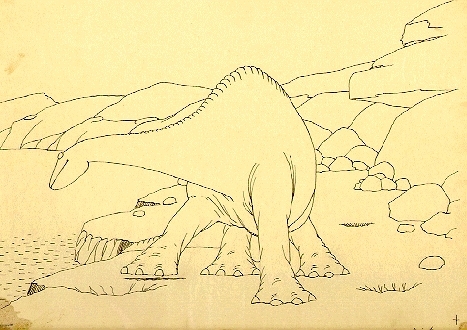
Gertie the Dinosaur. Credit: Wikimedia Commons.
And then, the Walt Disney Company stepped into the spotlightWalt Disney, the creative half of the duo, had already amassed experience producing short films based on popular fairy tales for Laugh-O-Gram Studio. When the studio went bankrupt, Walt moved to Hollywood and joined forces with his brother Roy, the business-minded half.
During an interview with a Canadian radio show many years later, Walt Disney would say, “I came to Hollywood and arrived here in August 1923 with $30 in my pocket and a coat and a pair of trousers that didn’t match. And one half of my suitcase had my shirts and underwear and things…the other half had my drawing materials.”
Despite the hardships, the brothers created the Disney Brothers Studio, where they produced short live-action/animated shorts (including their very first animated character, Oswald the Lucky Rabbit) before deciding they wanted to create a character they could call their own. The result? The birth of the world’s most famous mouse.
The Magnificent MouseWhen Mickey Mouse danced his way onto the screen in “Steamboat Willie” in 1928, it changed the world of animation forever. And it wasn’t just because of the adorable mouse himself. It was also because this was the first time an audience would hear synchronized sound accompanying animation — characters whistled and laughed, boats puffed smoke, birds sang. Remember, this was still the era of silent films, with just a few “talkies” (films with sound) starting to appear — so an animated film with synchronized sound was a big deal.
The animation world was set for another revolution in 1932 when Disney produced the first Technicolor cartoon, the silly symphony “Flowers and Trees.” Adding full color to cartoons made the characters and landscapes more vibrant and engaging and surely must have wowed audiences at the time.
This wasn’t an easy production either — to get a full-color film, Disney experts had to film with a special camera that separated the red, green, and blue components of the light and then process and project the films together to produce a full-color image on the screen.
Welcome to the Happiest Place on EarthAs the 30s made way for the 40s, Disney switched its focus to full-length animated features, starting in 1937 with “Snow White and the Seven Dwarfs” — which premiered to a record-breaking audience at the Carthay Circle Theatre in Los Angeles.
It was a daring move and a resounding success — the film cost $1.4 million to produce and grossed $8.5 million, the equivalent to hundreds of millions of dollars today. With that, the ‘Golden Age’ of animation had begun.
Disney produced some of its most beloved classics in the 1940s, including “Fantasia,” “Dumbo,” and “Bambi,” despite the challenges brought on by World War II — a time when many of Disney’s artists were drafted, forcing the studio to scale down production.
Walt Disney kept dreaming big, though, and in 1955 Disneyland opened its doors. He would later confess that the original idea came to him on a Saturday afternoon as he was sitting on a bench watching her two daughters riding a merry-go-round — “just a daddy with two daughters wondering where he could take them where he could have a little fun with them too.”
Disney’s commitment to family entertainment and storytelling has never waned. Today, the magic of Disney’s parks and films continue to inspire and entertain millions of visitors every year — all thanks to the dreams of a man who dared to imagine that a mouse could change the world.
By Diana Bocco, contributor for Ripleys.com
EXPLORE THE ODD IN PERSON! Discover hundreds of strange and unusual artifacts and get hands-on with unbelievable interactives when you visit a Ripley’s Odditorium!Source: It’s A Whole New World: 2023 Is Disney’s 100th Birthday
CARTOON 06-29-2023
Ripley Entertainment Inc.'s Blog
- Ripley Entertainment Inc.'s profile
- 52 followers






